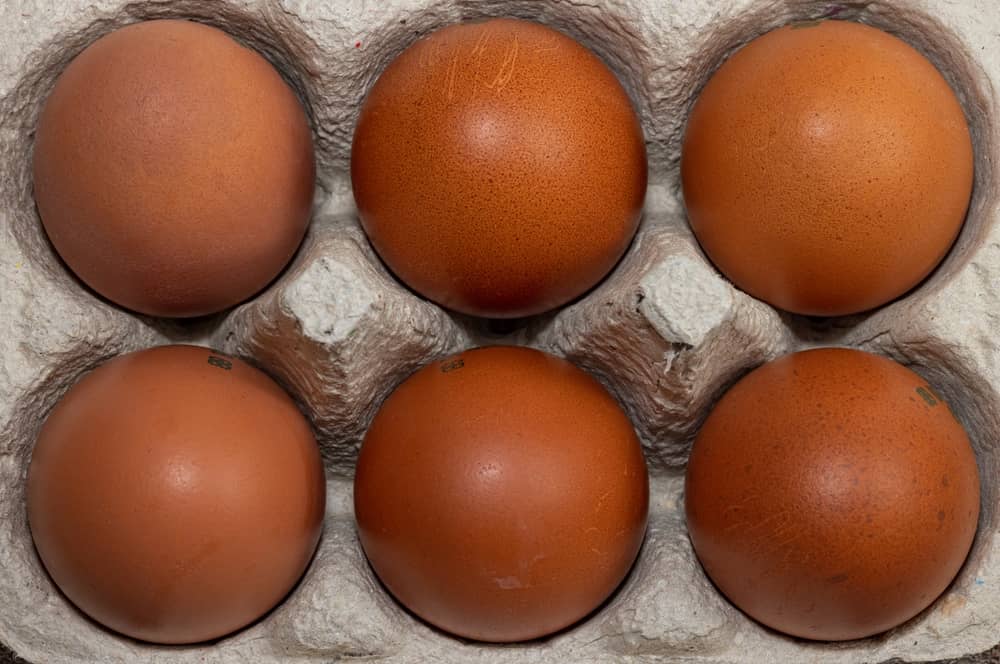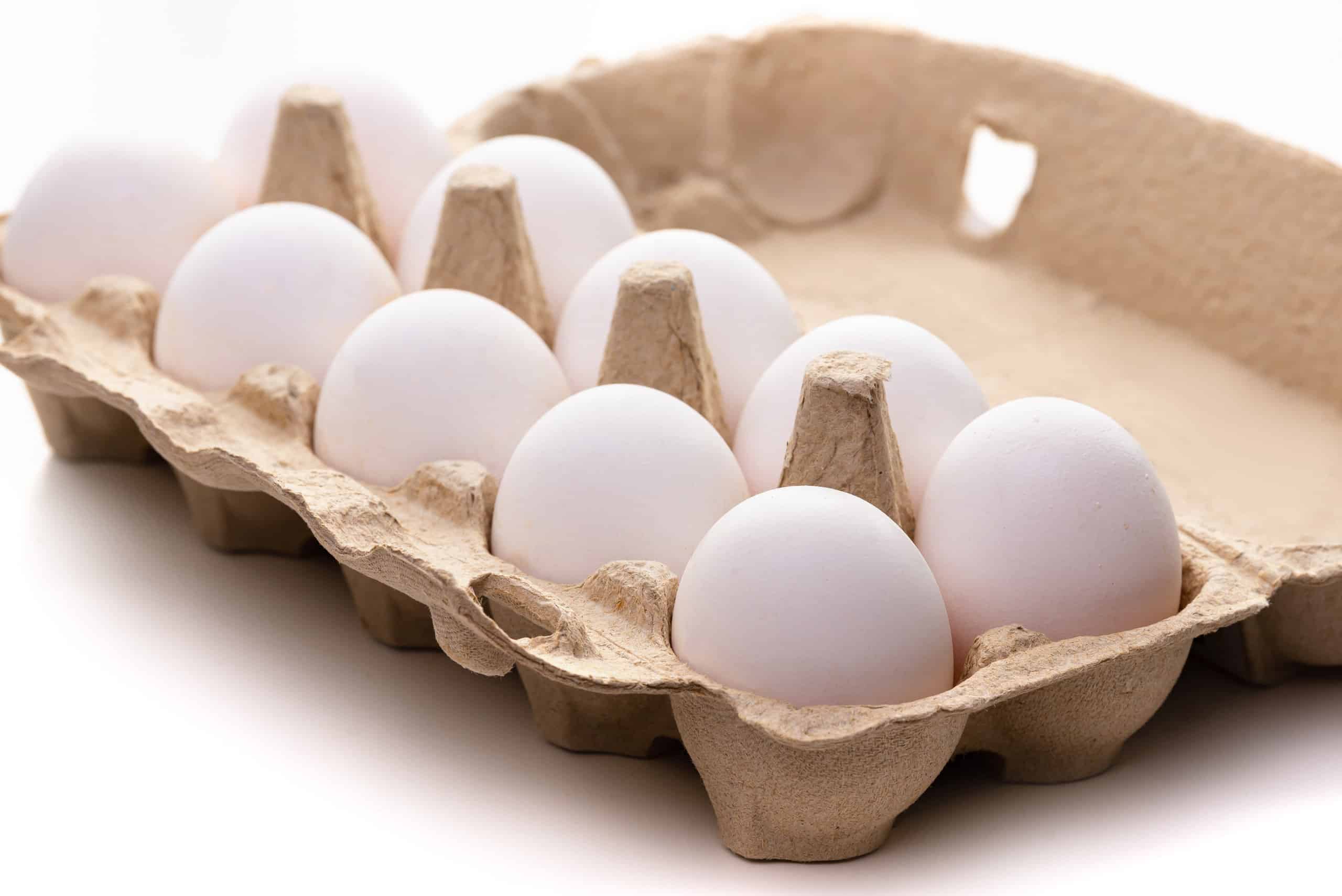While shopping at the grocery store you’ve probably made several observations as you browse for chicken eggs. The colors consumers frequently see in the store are white or brown.
Typically brown eggs are the more expensive variety, which may have led you to believe they are healthier. But did you know chicken eggs come in other shades such as pink and blue? And that color has nothing to do with how the nutritional value of the egg?
What Determines Egg Color?
Chicken eggs come in a variety of shades, but the factors that determine their color are pretty simple. According to Michigan State University, the breed of the hen determines what color egg she will produce. For example, Leghorn chickens lay white eggs while Plymouth Rock chickens lay brown eggs.
All eggs start out white in color, but some breeds of hen deposit a pigment into the egg as it travels through their oviduct, resulting in a colorful egg. One way to determine what color eggs a hen will lay is by taking a look at the animal’s earlobe color.
Are Brown Eggs Healthier Than White Eggs?
You’ve probably noticed that brown eggs are typically more expensive than white eggs, and that may have led you to believe they are healthier. However, according to Healthline, shell color has very little effect on the nutritional value of an egg.
In the past, brown eggs were more expensive because the hens that laid them were typically larger and more costly to feed. Brown eggs are also not as common as white eggs. Today production costs for chickens who lay white eggs vs brown eggs have evened out, but the higher cost for brown eggs remains.
Some factors that may determine how the hen was raised and the nutritional value of the egg include the following terms:
- Organic
- Cage-free
- Free-range
- Omega-3 enriched
- Backyard and local
It’s worth noting that these labels can be misleading. For example, “cage-free” hens often still live in very crowded environments. While organic refers to eggs from chickens that have been fed only organic and non-GMO feed, there is no evidence to show that these eggs have a higher nutritional value.
1. Green

Hens called olive eggers lay olive green colored eggs.
©Lou Sisneros Photography/Shutterstock.com
Green is one of the rarest egg colors of all and green eggs may come in a variety of shades. So how exactly do you get a green egg?
Breeds that lay green eggs are created by crossbreeding. Species such as the aptly named Olive Egger are born when a hen and rooster from a brown egg-laying and blue egg-laying breed mate.
The eggs of all hens travel through their oviduct in a process that takes around 26 hours. For olive eggers, a brown pigment overlays a blue eggshell, resulting in an olive green egg as the finished product.
Other chickens such as the Favaucana (half Faverolle and half Ameraucana), lay eggs in a paler shade of green. Typically the inside of the shell of a green egg will be blue, thanks to the pigment oocyanin.
Hens That Lay Green Eggs
| Breed | Shade |
|---|---|
| Olive Egger | Olive Green |
| Favaucana | Sage Green |
| Isbar | Mint Green |
2. Blue

The Ameraucana is one breed of chicken that lays rare blue eggs.
©Vampyre Zen/Shutterstock.com
Blue is another rare chicken egg color. Typically, blue chicken eggs come from breeds such as the Ameraucana, Araucana, or Cream Legbar chickens.
Ameraucanas are a breed of chicken first recognized by the American Poultry Association in the 1970s. They are one of the few breeds of chickens to lay blue eggs. This breed is derived from Aruacana chickens brought from Chile.
Unfortunately, Araucanas carry a gene that leads to unique-looking ear tufts as well as a high death rate during chicks’ incubation period. For this reason, Ameraucanas were bred to keep their blue egg-laying abilities but get rid of the lethal alleles of their parent breed. Their name is a combination of “Aruacana” and “America.”
When an Ameraucana chicken egg travel through its oviduct, a pigment known as oocyanin is deposited onto the egg. The pigment permeates the eggshell and turns it blue. Unlike brown eggs, this pigment changes the color of both the inside and outside of the shell.
Hens That Lay Blue Eggs
| Breed | Shade |
|---|---|
| Ameraucana | Light Blue |
| Araucana | Pale Blue or Bluish Green |
| Cream Legbar | Sky Blue |
3. Pinkish/Cream

Silkies may lay eggs that are cream or tinted light pink in color.
©Einar Muoni/Shutterstock.com
Unlike the previously discussed chickens, there is no one breed that will definitely lay pinkish-cream-colored eggs. This variation occurs somewhat randomly within breeds such as the Light Sussex or Faverolle, which typically lay cream to light-brown-colored eggs, says The Happy Chicken Coop.
When chickens that lay blue, green, or brown eggs are bred with a breed that carries the cream-colored egg gene, a pinkish variation may also occur. One such chicken is known as an Easter Egger.
Easter Eggers are hybrid chickens that are crossbred in order to lay eggs of various colors. The name doesn’t recognize one specific breed of chicken and isn’t recognized by the American Poultry Association. Regardless, Easter Eggers may lay eggs with various shades of brown, blue, pink, cream, or occasionally even pale yellow.
Hens That Lay Pinkish/Cream Eggs
| Breed | Shade |
|---|---|
| Light Sussex | Cream to Light Brown |
| Silkies | Cream or Tinted |
| Faverolles | Pink Tinted or Light Brown |
4. Brown

The eggs of the Marans chicken are deep chocolate brown.
©Carl DeAbreu Photography/Shutterstock.com
Today a variety of chickens lay brown eggs, making this egg color nearly as common as white. Some examples of breeds that lay brown eggs are Plymouth Rocks, Orpingtons, and Welsummers.
Chickens that lay brown eggs deposit the pigment protoporphyrin on the eggs during the process of it forming and traveling through the oviduct.
This pigment is deposited later in the process of forming the shell. As a result, only the outside of the egg is tinted with color. The inside shell of brown eggs remains white.
Occasionally, eggs also have a speckling pattern. According to the Silver Homestead, speckling is due to a slower rotation of the egg in the shell gland. In this instance, the protoporphyrin adheres to the shell in splotches rather than being spread as an even color.
Hens That Lay Brown Eggs
| Breed | Shade |
|---|---|
| Plymouth Rock | Light Brown |
| Orpington | Light Brown |
| New Hampshire | Tinted/Light Brown |
| Welsummer | Terra Cotta Brown with Speckles |
| Maran | Dark Brown |
| Penedesca | Dark Chocolate Reddish Brown |
5. White

White leghorns are capable of laying an average of 280 eggs per year.
©Nataliya Schmidt/Shutterstock.com
White is the most common chicken egg color. A variety of chickens lay white eggs, but one of the top-producing breeds is the White Leghorn. These hens lay an average of 280 eggs per year but may reach numbers over 300.
Interestingly, Leghorn hens rarely go broody — a term used to describe a hen that is committed to hatching its chicks. This is perhaps one reason leghorns are such productive layers. A broody hen takes the animal out of producing eggs for several weeks at a time.
As we’ve previously discussed, all eggs start out white in color in a hen’s oviduct. This is because eggshells are made of calcium carbonate. When an egg is laid white, it means no pigment was deposited into it as it traveled through the hen’s body.
While white eggs are pretty uniform in color, they certainly range in size. White Leghorns and Minorcas produce larger eggs, while eggs from a Hamburg or Lakenvelder may be smaller in size.
Hens That Lay White Eggs
| Breed | Shade |
|---|---|
| White Leghorns | White |
| Minorca | Chalk White |
| Ancona | White |
| Hamburg | White |
| California White | White |
| Lakenvelder | White/Tinted |
The photo featured at the top of this post is © Fburnette/Shutterstock.com
Thank you for reading! Have some feedback for us? Contact the AZ Animals editorial team.







